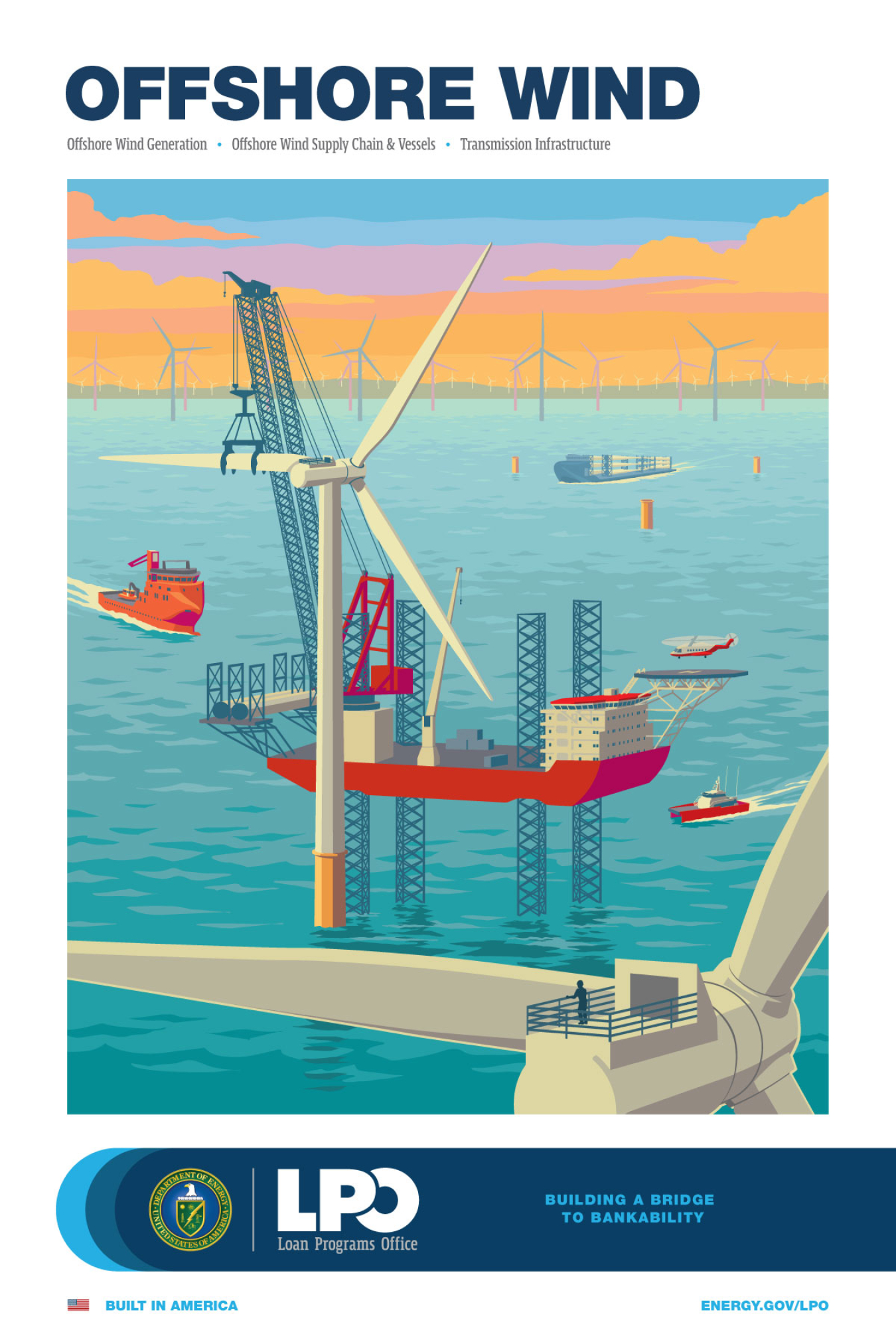
Download LPO's Offshore Wind poster.
The Department of Energy’s (DOE) Loan Programs Office (LPO) can support the deployment of offshore wind in the United States to create high-quality, good-paying jobs and increase access to abundant, affordable clean energy for all Americans.
President Biden’s Investing in America agenda, the Inflation Reduction Act (IRA), state policy frameworks, DOE initiatives, and electrification goals across the public and private sectors, lay the groundwork for widespread offshore wind deployment. The Biden-Harris Administration is dedicated to achieving its ambitious goal of deploying 30 gigawatts of new offshore wind energy by 2030, which estimates indicate will support 77,000 jobs, power 10 million homes, and cut 78 million metric tons of harmful carbon emissions. The sector is poised to play an important role in helping the nation reach the President’s bold vision of a net-zero electricity sector by 2035 and net zero economy by 2050.
LPO supports the sector by financing projects spanning the offshore wind value chain, from component manufacturing to offshore wind farm construction. In doing so, LPO can help strengthen the domestic clean energy supply chain, onshore quality manufacturing jobs, and increase clean energy deployment.
WHY Offshore wind?
As a relatively high-capacity factor, large-scale renewable resource, offshore wind power will play a key role in generating carbon-free electricity for America’s coasts, just as land-based wind power has successfully led the transition to carbon-free resources for America’s inland populations for over a decade. First, it relies on seafloor rather than land, the latter of which is in short supply near densely populated coastal areas. Second, offshore wind’s production profile in many places is complementary to land-based wind and solar, helping to balance out the variability in these other resources. Third, individual projects are typically large in this “go big or go home” industry; a single offshore wind farm is usually between 800 MW and 2,000 MW and can fundamentally shift generation and capacity dynamics in an area.
There are two broad categories of offshore wind infrastructure, fixed-bottom and floating, at different stages of maturity. In a fixed-bottom design, the structure supporting the turbine is fixed to the seafloor. While both types have been deployed at commercial scale globally, fixed-bottom offshore wind is more technologically mature and in widespread use globally, and there is enormous opportunity for the United States to manufacture and deploy this proven technology off American shores. Fixed-bottom offshore wind has been successfully deployed since the 1990s, with about 60 GW in operation globally today and another 30 GW under construction. That is significant capacity; for context, the United States had about 144 GW of installed land-based wind capacity as of 2022. It is common off the coasts of European countries in the North Sea and Asian nations in the Western Pacific. As of May 2022, projects totaling more than 18.5 GW were working through the permitting and offtake process, with one GW of fixed-bottom wind under construction off the East Coast of the United States.
In a floating offshore wind setup, turbines are installed on large floating structures that are anchored to the seabed with cabling, allowing for wind energy deployment in waters too deep for fixed-bottom approaches. Floating offshore wind technology is less mature but will play an important role in decarbonizing electricity in the United States and globally.
The Biden-Harris Administration is committed to building the domestic fixed-bottom and floating offshore wind industry vertical, from towers and turbines to cables and cranes. Onshoring the offshore wind supply chain will create quality jobs for American workers, increase energy security, and lead to economies of scale for this important clean energy technology to lower per unit energy costs. Recently, DOE, the National Renewable Energy Lab (NREL), and organizations across the U.S. government have developed strategies, action plans, and programs to support the offshore wind in the United States, including:
- Strategy to Advance Offshore Wind Energy in the United States (DOE, 2023): DOE’s strategy for advancing offshore wind energy in the United States to achieve the Biden-Harris Administration’s target of deploying 30 GW of offshore wind by 2030.
- Atlantic Offshore Wind Transmission Action Plan (DOE, 2023): Outlines immediate actions needed to connect the first generation of Atlantic offshore wind projects to the electric grid and longer-term efforts to increase transmission over the next several decades.
- Supply Chain Road Map for Offshore Wind Energy in the United States (NREL, 2022): Evaluates how the U.S. supply chain can evolve to support the national offshore wind target and position the industry for sustainable growth beyond 2030.
- Floating Offshore Wind Shot (U.S. government, 2022): Seeks to address remaining technical challenges for floating offshore wind and create economic opportunities for communities in the United States.
The Administration is also working to address permitting uncertainties and financial risks facing the industry. In August 2023, the U.S. Department of the Interior’s Bureau of Ocean Energy Management released guidance for offshore wind project submissions to make the permitting process more efficient.
Incentives in the IRA, including investment tax credits, associated tax credit bonuses, and $100 million for offshore wind transmission planning, as well as LPO financing, can improve offshore wind project economics, support infrastructure development, and strengthen domestic supply chains. These forms of government support are especially important now, when rising costs for materials and increasing costs of capital are making project economics more difficult for near-term projects. Developers and offtakers are renegotiating power purchase agreements priced years ago to reflect the current macroeconomic and global offshore wind market environment, and the government is working to fill remaining gaps and ensure short-term financial viability of offshore wind projects. Long-term project economics remain promising.
LPO offers competitively priced debt to projects across the offshore wind value chain. In doing so, LPO reduces the cost of capital to further improve near-term project economics, helping create quality jobs and reducing the cost of clean energy for American consumers.
How LPO CAN Help
LPO can finance a range of offshore wind-related projects that meet eligibility and programmatic requirements.
Projects may include, but are not limited to, manufacturing and/or deployment of:
- Supporting infrastructure: Manufacturing, construction, and installation of onshore and offshore transmission facilities: substations, converter stations, inter-array and export cables.
- Components: Construction of facilities that manufacture—or projects that manufacture – turbines, monopiles, towers, nacelles, blades, and foundations.
- Offshore wind farms: Deployment of fixed-bottom and floating offshore wind farms.
- Maritime vessels: Construction of facilities that manufacture—or projects that manufacture—qualifying maritime vessels and associated components.
- Ports: Construction of clean energy infrastructure to electrify ports (e.g., charging infrastructure for drayage, workboats, cranes).
LPO AUTHORITIES THAT CAN SUPPORT Offshore wind PROJECTS
LPO can finance offshore wind projects through several avenues:
- Title 17 Clean Energy Financing Program – Innovative Energy and Innovative Supply Chain Projects (Section 1703): Financing for clean energy projects, including offshore wind projects, that use innovative technologies or processes not yet widely deployed within the United States. These projects must show a meaningful reduction of lifecycle greenhouse gases emissions or air pollutants, either via the process itself or via the end use of the material.
- Title 17 Clean Energy Financing Program – State Energy Financing Institution (SEFI) – Supported Projects (Section 1703): Financing for qualifying clean energy projects, including for offshore wind projects, that receive meaningful financial support from a SEFI. These projects are not required to use innovative technologies.
- Title 17 Clean Energy Financing Program – Energy Infrastructure Reinvestment Projects (Section 1706): Financing for projects that retool, repower, repurpose, or replace energy infrastructure that has ceased operations or to enable operating energy infrastructure to avoid, reduce, utilize, or sequester air pollutants or anthropogenic emissions of greenhouse gases. These projects are not required to use innovative technologies.
- Tribal Energy Financing Program: Financing available to federally recognized tribes and qualified tribal energy development organizations for energy development projects, including offshore wind projects. These projects are not required to use innovative technologies.
- Advanced Technology Vehicles Manufacturing Program: Financing for U.S. facilities that manufacture advanced technology vehicles, and/or qualifying components and materials. Facilities that manufacture efficient vessels and/or eligible components, including maritime vessels which may be used in offshore wind projects, may qualify.
Offshore wind is vital to the nation’s clean energy transition and achieving the nation’s climate goals. Let LPO partner with you to make your project a reality.
NEXT STEPS
To learn more about how LPO could support your offshore wind-related project, please request a no-cost pre-application consultation. During the consultation, LPO will work with you to determine whether the project is eligible for financing.
To learn more about how DOE supports offshore wind-related projects across the research, development, demonstration, and deployment continuum, visit the Wind Energy Technologies Office.
Contributors: Emily Felt, Jonah Ury, and the Wind Energy Technologies Office.

